Wattle dividers offer a sustainable, budget-friendly solution for your urban garden. These versatile structures create distinct zones without overwhelming small spaces while supporting climbing plants and beneficial insects. You’ll enjoy their rustic elegance that complements both greenery and city architecture, plus they’re easily DIY-able using locally sourced materials. Their environmental benefits include creating microhabitats for pollinators and reducing urban heat island effects. Discover how this ancient technique provides modern solutions for your limited garden space.
Second-Level Headings for “Why Choose Wattle Dividers For Urban Gardens?”
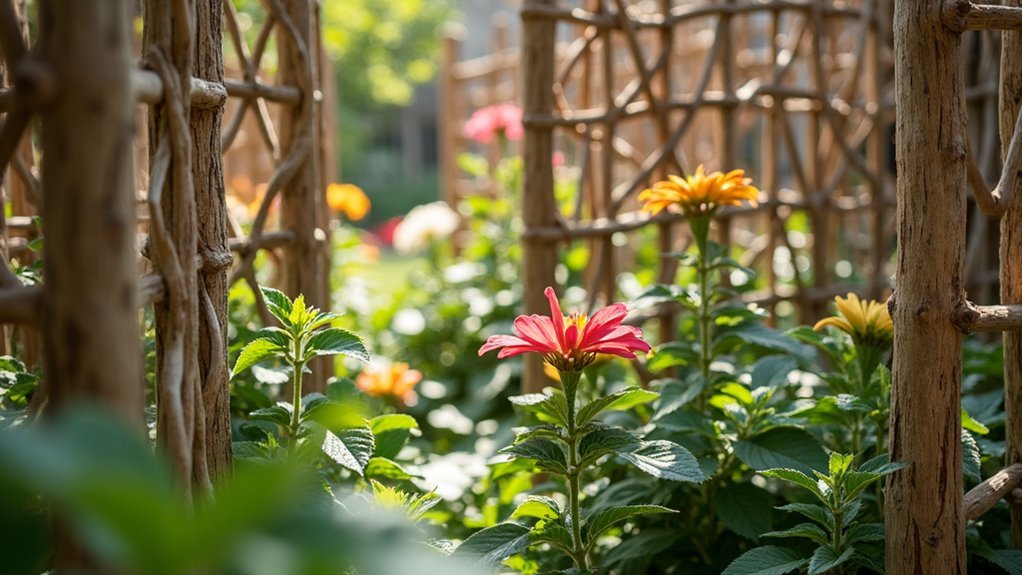
When planning your urban garden’s layout, selecting the right dividers becomes essential for both aesthetics and functionality. Wattle dividers offer compelling advantages worth considering for your space.
Your urban oasis can benefit from these natural structures through:
- Sustainable Materials and Eco-Friendly Design
- Soil Health Enhancement and Growth Promotion
- Versatile Applications for Limited Spaces
- Budget-Friendly DIY Possibilities
- Environmental Protection Benefits
Each heading addresses a critical aspect of wattle dividing systems that makes them ideal for city gardens.
You’ll discover how these traditional weaving techniques can solve modern gardening challenges while reducing your environmental footprint.
The beauty of wattle lies in its simplicity—transforming ordinary branches into functional garden elements that support both plants and ecological principles without breaking your budget. Their weaved construction provides both visual appeal and structural integrity, similar to wicker but built to withstand outdoor conditions.
The Ancient Art of Wattle Weaving in Modern Urban Settings
Wattle weaving spans thousands of years of human history, yet finds remarkable relevance in today’s urban gardens. This traditional craft connects you to your heritage while solving modern garden challenges. When you create these dividers, you’re participating in the same techniques your ancestors used for building homes and agricultural structures. The quick assembly process makes it an ideal project where children can assist, creating meaningful family gardening experiences.
- Living History: By incorporating wattle dividers, you transform your garden into a living educational space about historical building methods.
- Community Connection: Wattle weaving workshops can bring neighbors together, fostering community engagement through shared crafting.
- Cultural Expression: These handcrafted elements allow you to express cultural identity while adding artisanal charm to your urban oasis.
Modern tools have made this ancient practice more accessible, blending time-honored techniques with contemporary innovation.
Sustainable Materials for Eco-Conscious Urban Gardeners
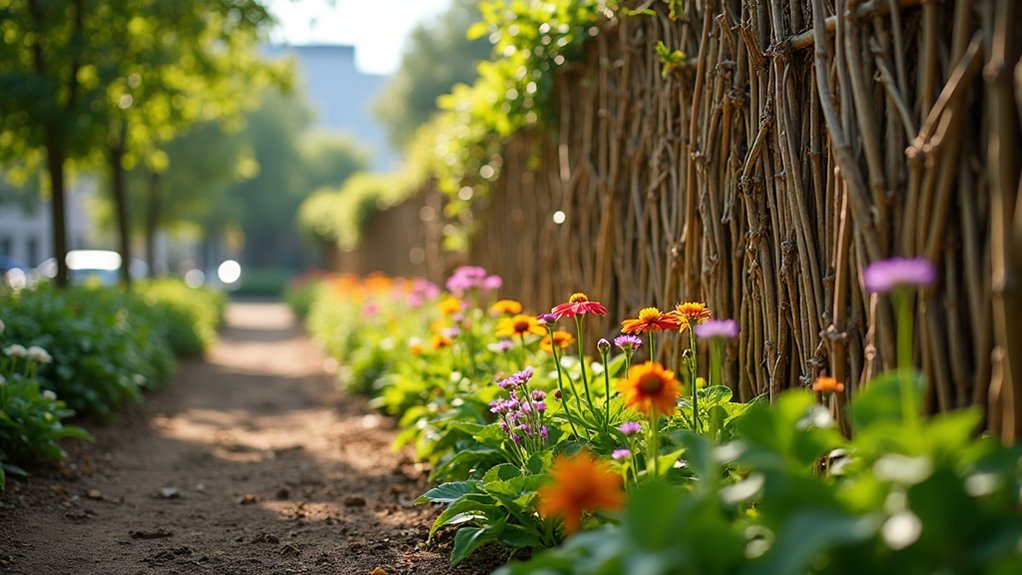
As urban gardeners increasingly prioritize environmental responsibility, selecting sustainable materials for your wattle dividers becomes essential for minimizing ecological impact.
Recycled wood pallets offer an excellent base material, reducing your carbon footprint while repurposing what would otherwise end up in landfills.
You’ll find bamboo particularly versatile due to its rapid growth cycle and natural durability. Ancient civilizations successfully employed trellises and espaliers for vertical plant growth, techniques that inform our modern wattle designs. For temporary dividers, consider biodegradable textiles like hemp or jute that will naturally decompose.
When sourcing materials locally, you’re not just supporting neighborhood businesses—you’re greatly reducing transportation emissions.
The modular nature of wattle dividers allows you to reconfigure your garden as needs change, while materials like mycelium-based composites represent the cutting edge of sustainable garden innovation.
Always verify that repurposed wood is free from harmful chemical treatments.
Creating Natural Boundaries in Limited Spaces
You can transform your compact urban garden with wattle dividers that create distinct zones without overwhelming limited space.
These natural boundaries work with your garden’s microclimate, offering shelter for tender plants while defining functional areas. Choosing varieties like Wirilda, Silver, and Golden Wattles provides rapid screening within just two years.
Your wattle borders won’t just separate spaces—they’ll become biodiversity hotspots, hosting beneficial insects and providing structure for climbing plants to thrive.
Maximize Urban Microclimates
Urban environments present unique challenges for gardeners, where limited spaces often suffer from heat islands, wind tunnels, and unpredictable microclimates. Wattle dividers offer a strategic solution to transform these conditions to your advantage. The wattle structure’s design effectively addresses urban heat island intensity by introducing natural elements that moderate temperature extremes in densely built areas. Their permeable structure disrupts problematic wind patterns while allowing beneficial airflow, creating protected zones for sensitive plants.
- Temperature control: Replace heat-absorbing surfaces with organic materials that reduce thermal mass and increase evapotranspiration through integrated vegetation.
- Wind management: Break up harsh urban canyon airflows with strategically positioned dividers that funnel gentle breezes where needed.
- Customizable zones: Create specialized growing areas by adjusting divider height, density, and positioning to trap warmth, channel water, or provide shade according to specific plant requirements.
These lightweight, modular structures adapt seasonally, giving you precise control over your garden’s microclimate without permanent modifications.
Define Without Dominating
Limited urban spaces require boundaries that define without overwhelming your garden’s aesthetic appeal. Wattle dividers strike this perfect balance by creating natural borders with lightweight, visually permeable structures that don’t dominate your green space.
Unlike solid walls or fences, these woven barriers blend seamlessly with your garden’s organic elements while still clearly delineating distinct growing zones.
You’ll appreciate how their adjustable heights (1-5 feet) and flexible configurations accommodate irregular plots and corner spaces—perfect for balconies or awkwardly shaped yards.
The open weave design allows essential airflow and filtered light to reach all plants while supporting climbers like peas and beans without additional trellises. These dividers can transform otherwise dangerous vacant urban lots into defined, productive garden spaces that benefit community health.
As they weather naturally over time, wattle dividers develop a pleasing patina that enhances rather than detracts from your urban oasis.
Biodiversity Within Borders
While boundaries primarily serve to define spaces, wattle dividers excel at fostering vibrant ecosystems within your urban garden’s borders.
These natural structures create micro-habitats that support diverse plant species and attract essential pollinators like bees and butterflies. Using stackable shelves alongside wattle dividers creates additional planting opportunities for herbs and flowers at various heights.
Your garden’s biodiversity thrives with these sustainable dividers as they:
- Provide shelter and nesting spaces for beneficial insects and small birds, creating a balanced ecosystem
- Support climbing plants that maximize vertical space while enhancing carbon sequestration
- Create protected microclimates that allow delicate plant varieties to flourish in otherwise challenging urban conditions
You’ll notice increased wildlife activity as these permeable barriers welcome nature rather than excluding it—transforming your garden into a functioning ecosystem rather than merely a decorative space.
Enhancing Soil Health Through Native Wattle Species
Native wattle species can transform your urban garden’s soil through their natural nitrogen-fixing abilities.
You’ll notice improved soil structure as these leguminous plants convert atmospheric nitrogen into forms that benefit surrounding vegetation.
Your garden ecosystem will thrive with better nutrient cycling and increased water retention, creating a healthier foundation for all your plants.
The Coastal Wattle Tree is particularly effective at enriching nutrient-poor soils while requiring minimal maintenance once established.
Native Nitrogen Fixers
Australian wattle species offer remarkable benefits to urban gardens through their natural nitrogen-fixing abilities, which can transform depleted soils into thriving ecosystems.
When properly nodulated with effective rhizobia, these native plants form symbiotic relationships that capture atmospheric nitrogen and convert it into plant-available forms. This process requires the enzyme nitrogenase complex to break the strong molecular bonds of atmospheric nitrogen.
You’ll appreciate these distinct advantages:
- Self-sustaining fertility – Wattles enrich your soil naturally, reducing or eliminating the need for chemical fertilizers.
- Drought tolerance – Many native wattle species have evolved to thrive in variable Australian conditions, maintaining their nitrogen-fixing capabilities even during dry periods.
- Biodiversity support – The improved soil fertility creates healthier growing conditions for companion plants, attracting beneficial insects and wildlife to your urban garden.
Urban Soil Regeneration
Transforming depleted urban soils into thriving ecosystems requires strategic approaches, and wattle species offer exceptional regenerative potential for city gardens.
You’ll find that Acacia-derived biochar considerably enhances water retention in sandy urban soils while simultaneously sequestering carbon for decades.
When you compost wattle biomass with other organic materials, you’re creating a premium amendment that meets EU organic fertilizer standards without phytotoxicity.
This compost-biochar combination improves soil structure, increases organic carbon, and enhances nutrient cycling—all while reducing your irrigation needs. Wattle species reach reproductive maturity quickly, allowing for sustainable harvesting cycles in urban garden projects.
DIY Wattle Construction: Steps and Techniques
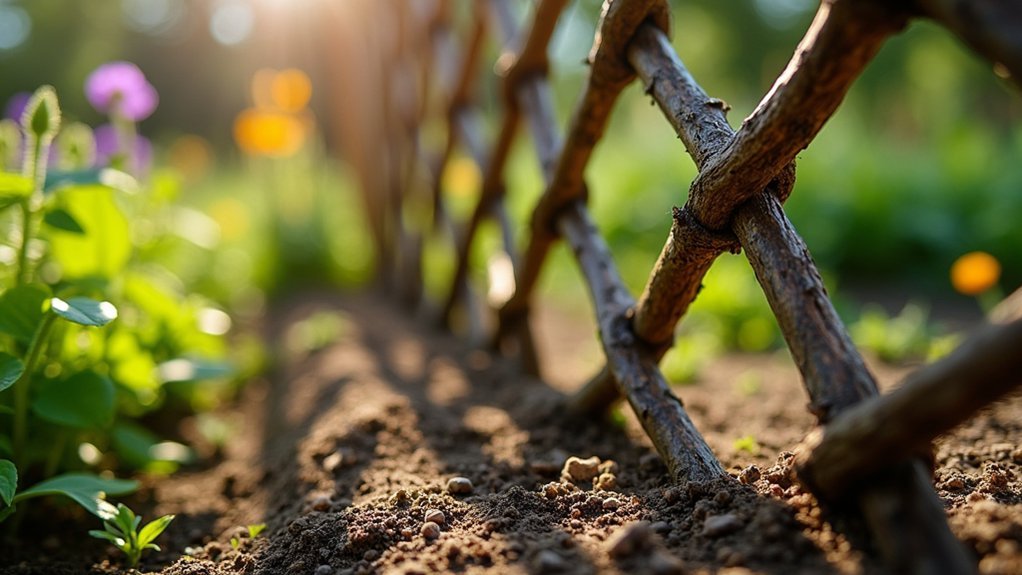
Crafting your own wattle dividers begins with proper preparation and material selection. Assess your garden space, then gather flexible branches, separating them into stakes (1.5″+ diameter) and weavers (less than 1″ diameter). Prioritize materials like willow or hazel harvested during dormancy for maximum flexibility.
Create a simple jig using scrap lumber with 1.5″ holes drilled at 16-18″ intervals to guarantee consistent stake placement. Once your stakes are secured 12″ into the ground, begin the weaving process:
- Alternate weave direction with each row, going over/under for structural integrity
- Maintain consistent tension by gently bending weavers during insertion
- Secure loose ends by tucking behind adjacent stakes or using plant-fiber ties
Apply linseed oil annually to prevent cracking and extend your wattle’s lifespan. Remember that using green wood for your project will provide better flexibility and make the weaving process significantly easier.
Cost Benefits of Natural Dividers vs. Commercial Options
You’ll find that wattle dividers cost considerably less than commercial options, with natural materials like willow or bamboo eliminating retail markups and transport expenses.
By harvesting materials yourself and using simple tools you already own, you’ll save both on materials and avoid specialized equipment rentals.
While these natural barriers may need replacement every 3-5 years, their ability to be composted and rebuilt with minimal expense makes them more cost-effective in the long run than their manufactured counterparts. Their simple design helps with sediment control during rainfall, preventing soil erosion in garden beds.
Comparing Material Costs
When comparing the costs of garden dividers, natural wattle fencing stands out as a remarkably economical alternative to commercial options.
You’ll find that willow or hazel materials can often be sourced locally at minimal or no cost, unlike manufactured fencing that carries hefty price tags from production and shipping.
The simplicity of wattle construction translates to significant savings on installation materials too—you won’t need expensive hardware, concrete footings, or specialized tools that commercial options typically require. Creating wattle fences can be done at absolutely no cost while still achieving beautiful, functional garden structures.
- Save by using salvaged or waste wood, an option rarely possible with pre-manufactured products
- Benefit from wattle’s flexibility that eliminates costly site preparation on uneven ground
- Reduce long-term expenses through easy, localized repairs rather than replacing entire panels
DIY Labour Savings
Diving into wattle divider construction reveals substantial cost savings beyond just materials.
You’ll appreciate the simplicity of using flexible branches and stakes, which eliminates the need for specialized tools or heavy machinery. Unlike commercial fence installation, wattle fence building doesn’t require professional skills or equipment rentals.
You can assemble these natural dividers quickly, cutting down on time investment while using materials often found locally or even in your own garden.
By repurposing pruned branches that would otherwise end up as waste, you’re avoiding disposal costs while creating something functional.
The straightforward over-under pattern for weaving allows even beginners to create sturdy sections with minimal practice.
The straightforward weaving technique means you can complete sections in a single afternoon—a significant advantage over commercial options that might require professional installation or extended construction periods.
This accessible DIY approach puts beautiful, functional garden dividers within reach of any urban gardener.
Long-term Cost Efficiency
Beyond the immediate DIY advantages, wattle dividers offer impressive long-term economic benefits that commercial alternatives simply can’t match.
By using locally sourced natural materials, you’ll eliminate transportation costs and avoid price volatility of industrial supply chains. These natural dividers biodegrade at the end of their lifecycle, saving you disposal fees that synthetic options would incur. Detroit’s urban agriculture movement has demonstrated how sustainable practices like these can strengthen community resilience while reducing costs.
- Material savings: Using pruning waste or surplus natural resources cuts procurement costs by 50-70% compared to commercial products
- Maintenance efficiency: Repairs require only readily available materials without specialized tools or skills
- Ecosystem benefits: Natural pest control habitat reduces your need for pesticides while improving soil health
The multi-functional nature of wattle dividers creates value beyond mere boundary marking—supporting garden productivity while lowering ongoing management expenses.
Seasonal Considerations for Wattle Maintenance
Maintaining your wattle dividers throughout the year requires attention to seasonal changes that affect their structural integrity and appearance.
In spring and summer, use fresh, flexible branches for weaving while reserving dried materials for posts. As weather warms, check for pests that emerge with new growth.
During summer’s heat and rain, secure loose elements and apply UV-resistant treatments if your dividers face direct sunlight.
Fall is ideal for inspecting decay before winter arrives—replace worn components promptly.
Winter brings unique challenges; protect your wattle from frost damage with protective layers.
In areas with high rainfall, guarantee proper drainage throughout all seasons to prevent erosion around your divider’s base.
Regular seasonal inspections will identify potential issues before they compromise your wattle’s structure or aesthetic appeal.
Biodiversity Benefits in Concrete Jungles
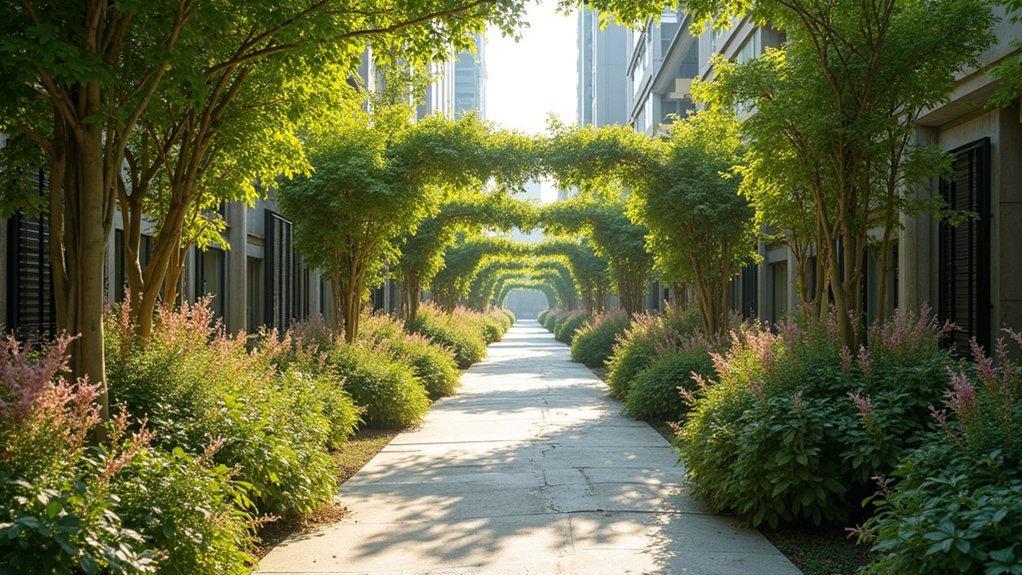
While urban environments often seem dominated by concrete and steel, wattle dividers in city gardens create essential sanctuaries for biodiversity.
By incorporating these natural barriers, you’re establishing microhabitats that attract pollinators, beneficial insects, and small wildlife to your garden.
When you install wattle dividers alongside diverse native plantings, you’ll transform your urban space into a thriving ecosystem that rivals natural areas in biodiversity value.
These structures help:
- Connect fragmented urban habitats, creating wildlife corridors for species movement
- Support multilayered vegetation that enhances soil health and water infiltration
- Provide nesting sites and shelter for birds and beneficial insects
Your wattle-divided garden becomes more than beautiful—it’s a functioning ecosystem contributing to urban cooling, flood mitigation, and ecological balance in your concrete jungle.
Aesthetic Appeal: Blending Function With Natural Beauty
The rustic elegance of wattle dividers transforms urban gardens from mere spaces into visually striking sanctuaries.
You’ll find the rough-hewn willow or hazelwood twigs create compelling contrast against polished city architecture while their earthy tones naturally complement surrounding greenery.
These Belgian imports offer authentic European charm through their irregular spacing, which filters light to cast dynamic shadow patterns throughout your garden.
As seasons change, the dividers provide constant structure while showcasing different plant features—summer blooms, autumn colors, or winter silhouettes.
You’ll appreciate how wattle’s matte texture offsets glossy urban surfaces without competing with your colorful florals.
Their organic lines counter rigid city geometry while creating a tactile, stress-reducing environment that develops character over time—blending function with biophilic beauty in your urban oasis.
Supporting Climbing Plants With Wattle Structures
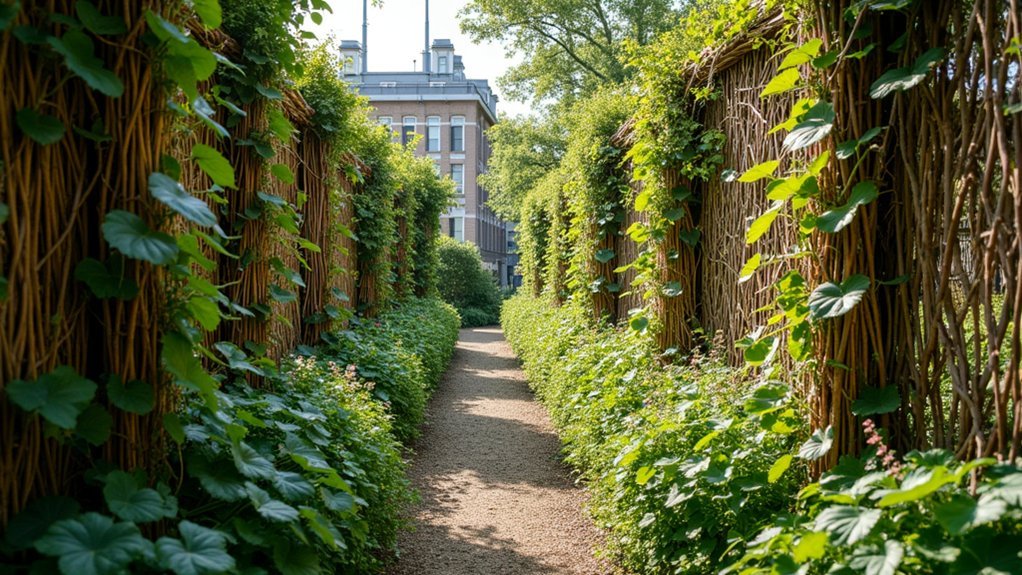
Climbing plants find their perfect partner in wattle structures, creating a living tapestry that transforms your urban garden. The tightly woven branches provide ideal support for peas, beans, roses, and other climbing varieties, while the diamond or horizontal weaving patterns give plants multiple attachment points as they grow.
You’ll appreciate how these structures offer both functionality and sustainability:
- Strong upright posts combined with flexible weaving materials create a durable framework that can last several growing seasons.
- Portable designs allow you to relocate your trellises as needed throughout different growing periods.
- Natural materials eventually decompose, enriching your soil while reducing your garden’s carbon footprint.
For best results, make certain your stakes are deeply rooted and your weave is tight, particularly if you’re in a windy location.
Adapting Wattle Techniques for Balconies and Terraces
Urban dwellers with limited outdoor space needn’t miss out on the charm of wattle structures. Your balcony or terrace can become a natural retreat with space-efficient wattle dividers that add rustic appeal without consuming precious square footage.
You’ll find wattle particularly versatile for small spaces—use it to create privacy screens on shared balconies or as supports for vertical gardens. These structures also offer practical benefits: they reduce urban noise, stabilize soil in elevated planters, and provide shade during hot months.
For terraced areas, wattle helps prevent erosion between levels while blocking unwanted views. It’s remarkably low-maintenance and can be adapted seasonally by changing the climbing plants you incorporate.
Weather Resistance and Longevity of Proper Wattle Work
Contrary to what many urban gardeners assume, properly constructed wattle dividers can withstand years of environmental challenges when built with durability in mind.
The secret lies in selecting weather-resistant branches and implementing regular maintenance to prevent decay.
Your wattle dividers’ lifespan depends largely on three key factors:
- Material selection – Choose hardwoods like hazel, willow, or dogwood that naturally resist rot and pest damage
- Construction quality – Tightly woven patterns and proper structural support greatly extend durability
- Environmental exposure – Position your dividers to minimize direct contact with ground moisture, and consider applying natural preservatives
Frequently Asked Questions
How Do Wattle Dividers Compare to Bamboo Screens for Urban Gardens?
Wattle dividers offer DIY flexibility and eco-benefits with local materials, while bamboo screens provide longer durability and immediate privacy. You’ll find wattle supports companion planting, but bamboo gives a cleaner, more modern aesthetic.
Can Wattle Dividers Be Safely Treated With Preservatives or Paints?
You can safely treat wattle dividers with natural preservatives like linseed oil. Avoid chemical treatments and synthetic paints, as they’ll harm garden soil and plants. Natural oils offer protection while maintaining eco-friendliness.
Are There Any Municipal Regulations Restricting Wattle Constructions?
You’ll likely face municipal regulations on wattle constructions including height restrictions, zoning laws, and material sourcing rules. Check your local building codes and obtain necessary permits before starting your project.
What Wildlife Might Be Attracted to or Deterred by Wattle Dividers?
You’ll attract native bees, small birds like Silvereyes, and beneficial insects to your wattle dividers. They’ll deter larger birds and predators, especially if you choose prickly varieties that create protective barriers for smaller wildlife.
How Do Wattle Dividers Perform During Extreme Weather Events?
Wattle dividers excel during extreme weather by stabilizing soil, managing runoff, and reducing erosion. You’ll find they maintain structural integrity even in heavy rainfall, filtering sediment and protecting your garden from storm damage effectively.
In Summary
You can’t go wrong with wattle dividers for your urban garden. Whether you’re seeking sustainability, natural aesthetics, or practical space division, these traditional structures deliver. They’ll support your climbing plants, improve soil health, and stand up to the elements while adding rustic charm. By incorporating wattle weaving into your garden design, you’re connecting with ancient techniques perfectly suited for today’s eco-conscious urban gardening.

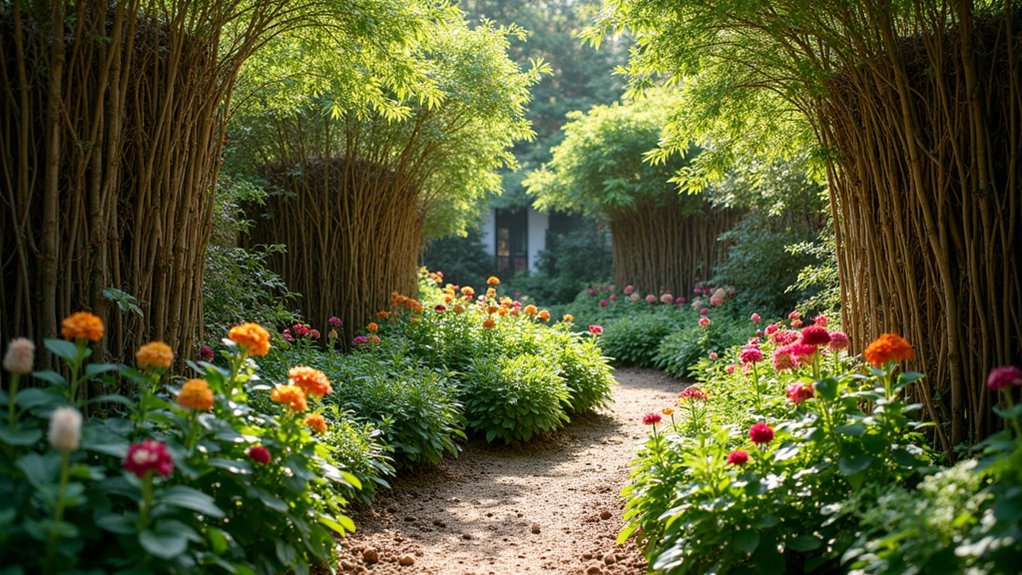



Leave a Reply